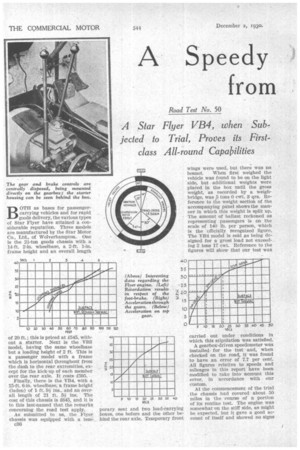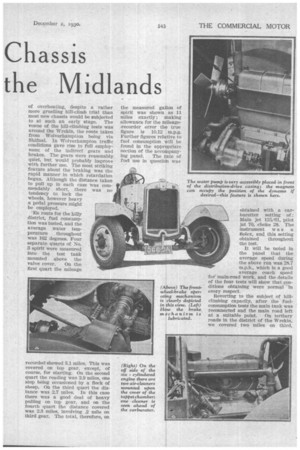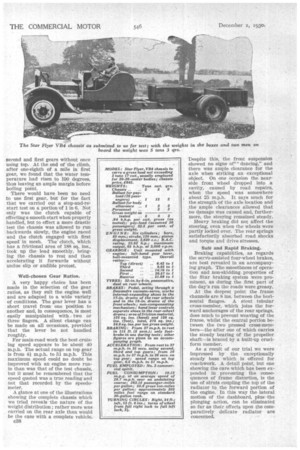A Speedy Chassis from the Midlands
Page 58

Page 59

Page 60

If you've noticed an error in this article please click here to report it so we can fix it.
BOTH as bases for passengercarrying vehicles and for rapid goods delivery, the various types of Star Flyer have attained a considerable reputation. Three models are manufactured by the Star Motor Co., Ltd., of Wolverhampton. One is the 2i-ton goods chassis with a 14-ft. 2-in, wheelbase, a 2-ft. 1-in. frame height and an overall length of 20 ft. ; this is priced at £545, without a starter. Next is the VB3 model, having the same wheelbase but a loading height of 2 ft. This is a passenger model with a frame which is horizontal throughout from the dash to the rear extremities, except for the kick-up of each member over the rear axle. It costs £595.
Finally, there is the VB4, with a 15-ft. 6-in, wheelbase, a frame height (laden) of 1 ft. 91 ins., and an overall length of 21 ft. 31 ins. The cost of this chassis is £645, and it is to this last-named that the remarks concerning the road test apply.
• As submitted to us, the Flyer chassis was equipped with a temc36 wings were used, but there was no bonnet. When first weighed the vehicle was found to be on the light 'side, but additional weights were placed in the box until the gross weight, as recorded by a weighbridge, was p tons 0 cwt. 3 qrs. Reference to the weight section of the accompanying panel shows the manner in which this weight is split up. The amount of ballast reckoned as representing passengers is on the scale of 140 lb. per person, which is the officially recognized figure. The VB4 model is sold ns being designed for a gross load not exceed-. ing 2 tons 17 cwt. Reference to the figures will show that our test was
carried out under conditions in which this stipulation was satisfied. A gearbox-driven speedometer was installed for the test and, when checked on the road, it was found to have an error of 7.7 per cent. AU figures relative to speeds and mileages in this report have been ' modified to take into account this error, in accordance with our custom.
At the commencement of the trial the chassis had covered about 50
40 miles in the course of a portion of its routine test. The engine was somewhat 'on the stiff side, as might be expected, but it gave a good account of itself and showed no signs
of overheating, despite a rather more gruelling hill-climb trial than most new chassis would be subjected to at such an early stage. The venue of the hill-climbing tests was around the Wrekin, the route taken from Wolverhamption being via Shifnal. In Wolverhampton traffic conditions gave rise to full employment of the indirect gears and brakes. The gears were reasonably quiet, but would probably improve with further use. The most striking feature about the braking was the rapid manner in which retardation began. Although the distance taken to pull up in each ease was commendably short, there was no tendency to lock the wheels, however heavy a pedal pressure might be employed.
4.En route for the hilly ,ffistrict, fuel cons-amntion was tested, and the average water temperature throughout was 162 degrees. Four separate quarts of No. 3 spirit were measured into the test tank mounted above the
valve cover. On the first quart the mileage recorded showed 3.1 miles. This was covered on top gear, except, of course, for starting. On the second quart the reading was 2.9 miles, one stop being occasioned by a flock of sheep. On the third quart the distance was 2.7 miles. In this case there was a good deal of heavy pulling on top gear, and on the fourth quart the distance covered was 2.3 miles, involving .2 mile on third gear. The total, therefore, on obtained with a carburetter setting of : Main jet 125/61, pilot jet 70, choke 28. The instrument was a Solex, and this setting obtained throughout the test.
It will be noted in the panel that the average speed during the above run was 28.7 m.p.h., which is a good average coach speed formain-road work, and the details of tile four tests will show that conditions obtaining were normal in every respect.
Reverting to the subject of hillclimbing capacity, after the fuelconsumption testa the main tank was reconnected and the main road left at a suitable point. On tertiary roads in the district of the Wrekin, we covered two miles on third, Second and first gears without once using top.At the end of the climb, after one-eighth of a mile in first gear, we found that the water temperature had risen to 190 degrees, thus leaving an ample margin before boiling point.
There would have been no need to use first gear, but for the fact that we carried out a stop-and-restart test on a portion of 1 in 6. Not only was the clutch capable of effecting a smooth start when properly handled, but to effect a more drastic test the chassis was allowed to run backwards slowly, the engine raced and the clutch engaged with first speed in mesh. The' clutch, which has a frictional area of 188 sq. ins., took up the load smoothly, bringing the chassis to rest and then accelerating it forwards without undue slip or audible protest.
Well-chosen Gear Ratios.
A very happy choice has been made in the selection of the gear ratios, as they suit the engine well and are adapted to a wide variety of conditions. The gear lever has a short travel from' one position to another and, in consequence, is most easily manipulated with two or three fingers. A silent change can be made on all occasions, provided that the lever be not handled roughly.
For main-road work the best cruising speed appears• to be about 40 • m.p.h. The actual range on top gear is from 41 m.p.h. to 51 m.p.h. This maximum speed could no doubt be Improved with an engine more runin than was that of the test chassis, but it must be remembered that the speed quoted was a true reading and not that recorded by the speedometer.
A glance at one of the illustrations showing the complete chassis which we tried reveals the nature of the weight distribution ; rather more was carried on the rear axle than would be the case with a complete vehicle.
e38
Despite this, the front suspension showed no signs of" dancing," and there was ample clearance for the axle when striking an exceptional object. On one occasion the nearside front wheel dropped into a cavity, caused by road repairs, when the speed was somewhere about 25 m.p.h. It says much for the strength of the axle location and the ample clearances allowed that no damage was caused and, furthermore, the steering remained steady.
Heavy braking did not affect the steering, even when the wheels were partly locked over. The rear springs satisfactorily absorbed road shocks and torque and drive stresses.
Safd and Rapid Braking.
Braking capabilities, as regards the servo-assisted four-wheel brakes, are best revealed in an accompanying graph. The smoothness of operation and non-skidding properties of the Star braking system were prominent, as during the first part of the day's run the roads were greasy.
At the deepest point the frame channels are 8 ins. between the horizontal flanges. A stout tubular cross-member, which joins the forward anchorages of the rear springs, does much to prevent weaving of the frame, whilst the central portion between the two pressed cross-emhers—the after one of which carries the steady bearing of the propeller shaft—is braced by a built-up cruciform member.
As a result of our trial we were impressed by the exceptionally steady base which is offered for coachwork. A detail point, but one showing the care which has been expended in preventing the consequences of frame distortion, is the use of struts coupling the top of the radiator to the forward portion of the engine. In this way the lateral motion of the dashboard, plus the plunging action, can be eliminated so far as their effects upon the comparatively delicate radiator are concerned.












































































































